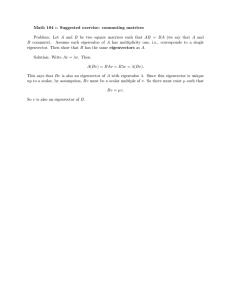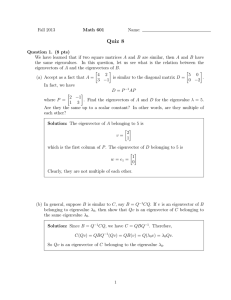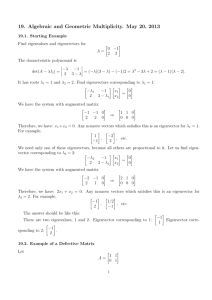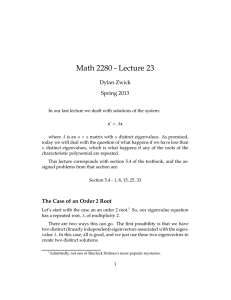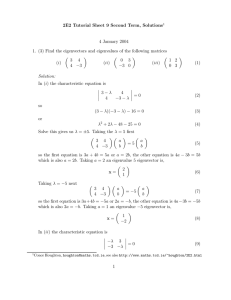Math 2280 - Lecture 23 Dylan Zwick Spring 2013
advertisement
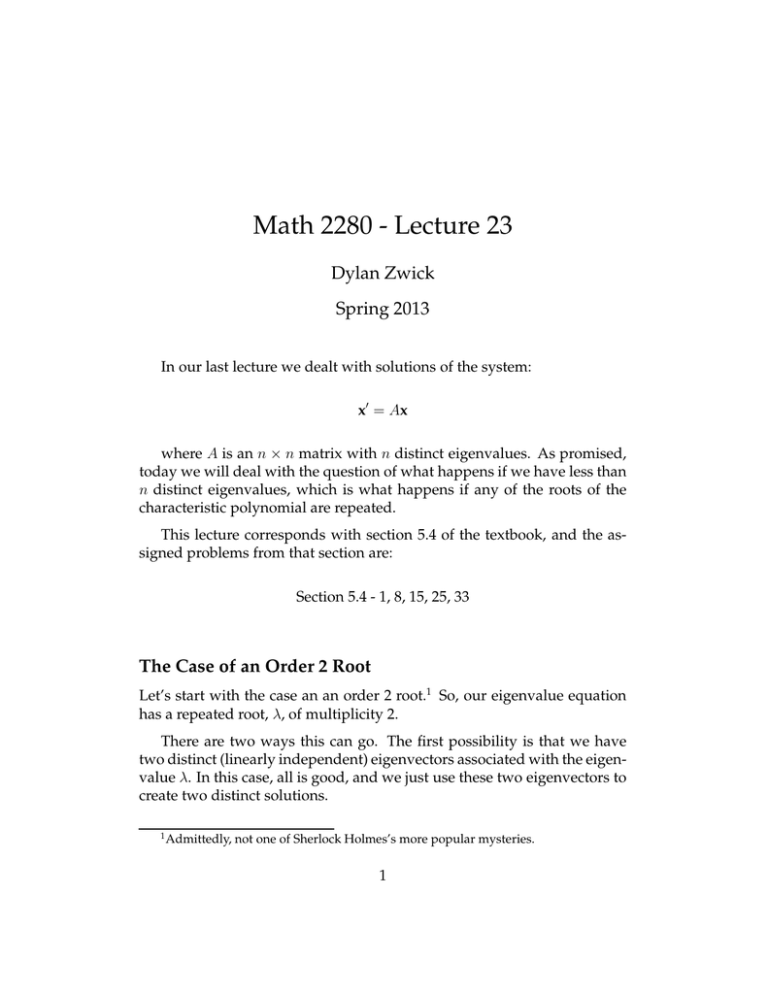
Math 2280 - Lecture 23
Dylan Zwick
Spring 2013
In our last lecture we dealt with solutions of the system:
x′ = Ax
where A is an n × n matrix with n distinct eigenvalues. As promised,
today we will deal with the question of what happens if we have less than
n distinct eigenvalues, which is what happens if any of the roots of the
characteristic polynomial are repeated.
This lecture corresponds with section 5.4 of the textbook, and the assigned problems from that section are:
Section 5.4 - 1, 8, 15, 25, 33
The Case of an Order 2 Root
Let’s start with the case an an order 2 root.1 So, our eigenvalue equation
has a repeated root, λ, of multiplicity 2.
There are two ways this can go. The first possibility is that we have
two distinct (linearly independent) eigenvectors associated with the eigenvalue λ. In this case, all is good, and we just use these two eigenvectors to
create two distinct solutions.
1
Admittedly, not one of Sherlock Holmes’s more popular mysteries.
1
Example - Find a general solution to the system:
9
4 0
x′ = −6 −1 0 x
6
4 3
Solution - The characteristic equation of the matrix A is:
|A − λI| = (5 − λ)(3 − λ)2 .
So, A has the distinct eigenvalue λ1 = 5 and the repeated eigenvalue
λ2 = 3 of multiplicity 2.
For the eigenvalue λ1 = 5 the eigenvector equation is:
a
0
4
4
0
b
0
−6 −6 0
=
(A − 5I)v =
c
0
6
4 −2
which has as an eigenvector
1
v1 = −1 .
1
Now, as for the eigenvalue λ2 = 3 we have the eigenvector equation:
6
4 0
a
0
−6 −4 0 b = 0 .
6
4 0
c
0
For this eigenvector equation we have two linearly independent eigenvectors:
2
0
2
v2 = 0 and v3 = −3 .
1
0
So, we have a complete set of linearly independent eigenvectors, and
associated solution:
x(t) = c1 v1 e5t + c2 v2 e3t + c3 v3 e3t
Well, that was no problem. Unfortunately, as we will see momentarily,
it isn’t always the case that we can find two linearly independent eigenvectors for the same eigenvalue.
Example - Calculate the eigenvalues and eigenvectors for the matrix:
A=
1 −3
3 7
Solution - We have characteristic equation (λ − 4)2 = 0, and so we have
a root of order 2 at λ = 4. The corresponding eigenvector equation is:
(A − 4I) =
−3 −3
3
3
a
b
=
0
0
.
We get one eigenvector:
v=
1
−1
and that’s it!
In this situation we call this eigenvalue defective, and the defect of this
eigenvalue is the difference beween the multiplicity of the root and the
3
number of linearly independent eigenvectors. In the example above the
defect is of order 1.
Now, how does this relate to systems of differential equations, and how
do we deal with it if a defective eigenvalue shows up?2 Well, suppose we
have the same matrix A as above, and we’re given the differential equation:
x′ = Ax.
For this differential equation we know how to find one solution:
1
−1
e4t
but for a complete set of solutions we’ll need another linearly independent solution. How do we get this second solution?
Well, based upon our previous experience we may think that, if v1 eλt
is a solution to our system, then we can get a second solution of the form
v2 teλt . Let’s try this solution out in our differential equation:
v2 eλt + λv2 teλt = Av2 teλt .
Unfortunately for this to be true it must be true when t = 0, which
would imply that v2 = 0, which wouldn’t be a linearly independent solution. So, this approach doesn’t work.3
But wait, there’s hope. We don’t have to abandon this method entirely.4
Suppose instead we modify it slightly and replace v2 t with v1 t + v2 , where
v1 is the one eigenvector that we were able to find. Well, if we plug this
into our differential equation we get the relations:
v1 eλt + λv1 teλt + λv2 eλt = Av1 teλt + Av2 eλt .
2
No, run and hide is not an acceptable answer.
Nuts!
4
Hooray!
3
4
If we equate the eλt terms and the teλt terms we get the two equalities:
(A − λI)v1 = 0
and
(A − λI)v2 = v1 .
Let’s think about this. What this means is that, if we have a defective
eigenvalue with defect 1, we can find two linearly independent solutions
by simply finding a solution to the equation
(A − λI)2 v2 = 0
such that
(A − λI)v2 6= 0.
If we can find such a vector v2 , then we can construct two linearly
independent solutions:
x1 (t) = v1 eλt
and
x2 (t) = (v1 t + v2 )eλt
where v1 is the non-zero vector given by (A − λI)v2 .
For our particular situation we have:
2
(A − 4I) =
0 0
0 0
So, any non-zero vector could potentially work as our vector v2 . If we
try
5
v2 =
1
0
then we get:
−3 −3
3
3
1
0
=
−3
3
So, our linearly independent solutions are:
4t
x1 (t) = v1 e =
−3
3
e4t ,
and
4t
x2 (t) = (v1 t + v2 )e =
−3t + 1
3t
e4t .
with corresponding general solution:
x(t) = c1 x1 (t) + c2 x2 (t).
We note that our eigenvector v1 is not our original eigenvector, but is a
multiple of it. That’s fine.
The General Case
The vector v2 above is an example of something called a generalized eigenvector. If λ is an eigenvalue of the matrix A, then a rank r generalized eigenvector associated with λ is a vector v such that:
(A − λI)r v = 0
but
(A − λI)r−1 v 6= 0.
6
We note that a rank 1 generalized eigenvector is just our standard eigenvector, where we treat a matrix raised to the power 0 as the identity matrix.
We define a length k chain of generalized eigenvectors based on the eigenvector v1 as a set {v1 , . . . , vk } of k generalized eigenvectors such that
(A − λI)vk = vk−1
(A − λI)vk−1 = vk−2
..
.
(A − λI)v2 = v1 .
Now, a fundamental theorem from linear algebra states5 that every n ×
n matrix A has n linearly independent generalized eigenvectors. These n
generalized eigenvectors may be arranged in chains, with the sum of the
lengths of the chains associated with a given eigenvalue λ equal to the
multiplicity of λ (a.k.a. the order of the root in the characteristic equation).
However, the structure of these chains can be quite complicated.
The idea behind how we build our solutions is that we calculate the
defect d of our eigenvalue λ and we figure out a solution to the equation:
(A − λI)d+1 u = 0.
We then successively multiply by the matrix (A − λI) until the zero
vector is obtained. The sequence gives us a chain of generalized eigenvectors, and from these we build up solutions as follows (assuming there are
k generalized eigenvectors in the chain):
x1 (t) = v1 eλt
x2 (t) = (v1 t + v2 ) eλt
1 2
x3 (t) =
v1 t + v2 t + v3 eλt
2
5
This is mathspeak for “A theorem that’s true but we’re not going to prove. So just
trust me.”
7
..
.
xk (t) =
t2
tk−1
+ · · · + vk−2 + vk−1 t + vk eλt
v1
(k − 1)1
2!
We then amalgamate all these chains of generalized eigenvectors, and
these gives us our complete set of linearly independent solutions.6 This
always works. We note that in all the examples we’re doing we’re assuming all our eigenvalues are real, but that assumption isn’t necessary. This
method works just fine if we have complex eigenvalues, as long as we
allow for complex eigenvectors as well.
Example - Find the general solution of the system:
0
1
2
x′ = −5 −3 −7 x.
1
0
0
Solution - The characteristic equation of the coefficient system is:
−λ
1
2 |A − λI| = −5 −3 − λ −7 = −(λ + 1)3
1
0
−λ and so the matrix A has the eigenvalue λ = −1 with multiplicity 3. The
corresponding eigenvector equation is:
1
1
2
a
0
−5 −2 −7 b = 0 .
1
0
1
c
0
The only eigenvectors that work here are of the form:
6
In practice we’ll only be dealing with smaller (2x2, 3x3, maybe a 4x4) systems, so
things won’t get too awful.
8
a
a
−a
and so the eigenvalue λ = −1 has defect 2. In order to figure out the
generalized eigenvectors, we need to calculate (A − λI)2 and (A − λI)3 :
−2
(A − λI)2 = −2
2
0
(A − λI)3 = 0
0
−1 −3
−1 −3
1
3
0 0
0 0 .
0 0
So, what we want to do is find a vector v such that (A − λI)3 v = 0 (not
hard to do) but also such that (A − λI)2 v 6= 0 (also not hard to do, but
perhaps not trivial). Let’s try the simplest vector we can think of:
1
v = 0 .
0
If we test this out we get:
(A − λI)3 v = 0 (obviously)
−2 −1 −3
1
1
(A − λI)2 v = −2 −1 −3 0 = −5
2
1
3
0
1
So, all is good here, and we can use this other vector to get our final
generalized eigenvector:
1
1
2
1
−2
−5 −2 −7 −5 = −2
1
0
1
1
2
9
Using these three generalized eigenvectors we recover our three linearly independent solutions:
−2
x1 (t) = −2 e−t
2
−2
1
x2 (t) = −2 te−t + −5 e−t
2
1
−2
1
1
1 2 −t
−t
−2
−5 te +
0 e−t
x3 (t) =
te +
2
2
1
0
and so our general solution will be:
x(t) = c1 x1 (t) + c2 x2 (t) + c3 x3
where the constants c1 , c2 and c3 are determined by initial conditions.
10
